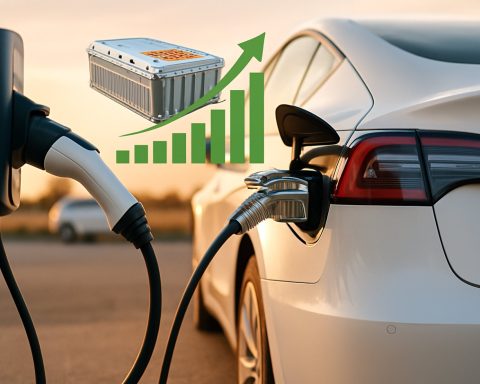- Pennsylvania State University engineers have revolutionized battery technology with a new solid-state electrolyte method.
- Solid-state batteries offer greater safety and efficiency, eliminating the fire hazards associated with traditional lithium-ion batteries.
- The NASICON-phase LATP structure enhances conductivity and safety within solid-state batteries.
- Cold sintering, operating at just 150°C, significantly reduces manufacturing costs and energy use compared to traditional high-temperature sintering.
- Incorporation of PILG at the grain boundaries of LATP ceramics improves ion transport and efficiency.
- Solid-state batteries have the potential to surpass lithium-ion batteries in power output and safety.
- Cold sintering may also enhance semiconductor manufacturing by improving thermal management and durability.
- This innovation signals a shift towards safer, more sustainable portable power solutions.
In the quiet halls of Pennsylvania State University, a team of visionary engineers has sparked a revolution in battery technology, unveiling a groundbreaking method to produce solid-state electrolytes. With a focus on enhancing safety and efficiency, this discovery stands poised to transform the landscape of portable power, leaving the volatile days of lithium-ion batteries behind.
The journey of lithium-ion batteries began in the 1970s with the pioneering work of M. Stanley Whittingham. Despite their ubiquitous presence in today’s electronics, from smartphones to electric vehicles, these batteries harbor hidden dangers: the ominous threat of thermal runaway. This perilous condition, often leading to fires and explosions, stems from the liquid electrolytes that facilitate the energy transfer within these batteries.
The quest for safer alternatives has led engineers to the fascinating realm of solid-state batteries. Unlike their liquid counterparts, solid-state batteries incorporate solid electrolytes, promising not only higher energy density but also a formidable resistance to fire hazards. This leap in technology is embodied in the NASICON-phase Li1.3Al0.3Ti1.7(PO4)3 (LATP) structure, which boasts an innovative ceramic matrix that significantly enhances conductivity and safety.
However, the path to mass production has been littered with challenges. Traditional manufacturing techniques, particularly high-temperature sintering, have proven to be formidable barriers due to their energy-intensive and material-damaging nature. Enter cold sintering—an ingenious approach pioneered by Penn State engineers. By mirroring the natural geological processes, this method utilizes minimal heat and pressure to meld dissimilar materials into a cohesive solid-state electrolyte, reducing costs and energy consumption dramatically.
Remarkably, cold sintering operates at a mere 150 degrees Celsius, a significant drop from the 900 degrees Celsius required by conventional methods. This temperature reduction not only lowers manufacturing barriers but also opens the door to experimenting with advanced materials that were previously unimaginable.
Central to this innovation is the LATP-PILG combination, a clever integration of poly-ionic liquid gel with LATP ceramics. By strategically placing the highly conductive PILG at grain boundaries, this composition allows for smoother ion transport and improved efficiency, pushing the performance of solid-state batteries beyond previous limits.
Testing has validated the promise of this new electrolyte design, showcasing a remarkable voltage window and enhanced conductivity, even at room temperature. With the potential to surpass current lithium-ion batteries in both power output and safety, solid-state technology is poised to redefine modern electronics, from consumer gadgets to electric vehicles.
But the implications of cold sintering extend beyond just battery technology. It harbors the potential to transform semiconductor manufacturing, offering enhanced thermal management and durability in a range of electronic devices. As the march toward commercialization gains momentum, the prospect of safer, more reliable batteries and advanced semiconductor technologies inches closer to reality.
In a world reliant on portable power, the promise of solid-state electrolytes marks a pivotal shift towards a safer, more sustainable future. With Penn State’s innovation lighting the way, the era of explosive batteries may soon be a relic of the past, replaced by robust and efficient power solutions that propel us into the future with confidence.
A Revolutionary Leap in Battery Safety and Efficiency: Unpacking Penn State’s Solid-State Electrolytes
The groundbreaking research spearheaded by engineers at Pennsylvania State University represents a monumental leap forward in battery technology, specifically in the development of solid-state electrolytes. This innovative approach is poised to address the longstanding safety concerns associated with traditional lithium-ion batteries while offering enhanced efficiency. Here’s a deeper dive into the implications and future potential of this fascinating evolution in portable power.
The Pioneering Shift from Liquid to Solid Electrolytes
The transition from liquid to solid-state electrolytes is a landmark in battery innovation. Unlike liquid electrolytes, which have historically posed risks of thermal runaway leading to fires and explosions, solid-state electrolytes promise enhanced safety and stability. This advancement is exemplified by the NASICON-phase Li1.3Al0.3Ti1.7(PO4)3 (LATP) structure, which combines a ceramic matrix with a poly-ionic liquid gel (PILG).
Key Features and Innovations:
– Cold Sintering Process: Developed by Penn State engineers, this approach uses significantly lower temperatures (150 degrees Celsius) compared to traditional sintering (900 degrees Celsius). The reduced temperature mitigates energy consumption and material degradation, thereby making high-efficiency solid-state electrolytes more accessible for mass production.
– Enhanced Conductivity: By strategically positioning PILG at grain boundaries within the LATP ceramic structure, the design fosters smoother ion transport, resulting in improved performance metrics, such as a remarkable voltage window and increased conductivity at room temperature.
Real-World Applications and Benefits
– Consumer Electronics: Solid-state batteries promise to extend the battery life of devices such as smartphones and laptops while minimizing potential hazards associated with overheating and battery swelling.
– Electric Vehicles: These batteries could significantly increase the mileage range and charging speed capabilities for EVs, while also reducing the risk of battery-related malfunctions which are critical factors for widespread EV adoption.
– Semiconductor Manufacturing: Beyond batteries, the cold sintering process has potential applications in semiconductor manufacturing, potentially offering improved thermal management and the ability to integrate more advanced materials.
Market Forecasts and Industry Trends
– Growth Trajectories: According to [Grand View Research](https://grandviewresearch.com), the global solid-state battery market is projected to grow exponentially, driven by increased demand for safer, energy-efficient power solutions across various industries.
– Investment and Innovation: Major companies, including automotive and tech giants, are increasingly investing in solid-state battery technology, indicative of industry readiness to transition toward safer and more efficient battery systems.
Pros and Cons Overview
Pros:
– Higher energy density, potentially prolonging battery life.
– Increased safety by eliminating risks of leaks and thermal runaways.
– Reduced carbon footprint due to lower manufacturing temperatures.
Cons:
– High initial costs associated with transitioning manufacturing processes.
– Technical challenges associated with scaling production.
Actionable Recommendations
1. Stay Informed: For consumers interested in safer electronics, keeping abreast of developments in solid-state technology will be essential. Ensure that future device upgrades consider these advancements for enhanced safety.
2. Industry Readiness: Companies should explore partnerships with research institutions to incorporate cold sintering methods into their production lines, paving the way for more durable, efficient electronics.
3. Investment Strategy: Investors can look into startups and established companies delving into solid-state battery research, as their rapid growth potential represents a promising opportunity.
For more insights on advancements in technology and sustainability, visit [Penn State’s official site](https://psu.edu).
As we move toward a future underscored by sustainability and safety, solid-state electrolytes at the heart of Penn State’s research offer a promising avenue to a more reliable power landscape. With these breakthroughs, the perils of explosive, inefficient batteries may soon become a thing of the past, ushering in an era defined by robust and sustainable energy solutions.












